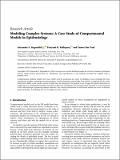Modeling Complex Systems: A Case Study of Compartmental Models in Epidemiology
Author(s)
Siegenfeld, Alexander F.; Kollepara, Pratyush K.; Bar-Yam, Yaneer
DownloadCOMPLEXITY.2022.3007864.pdf (998.5Kb)
Publisher with Creative Commons License
Publisher with Creative Commons License
Creative Commons Attribution
Terms of use
Metadata
Show full item recordAbstract
Compartmental epidemic models have been widely used for predicting the course of epidemics, from estimating the basic reproduction number to guiding intervention policies. Studies commonly acknowledge these models’ assumptions but less often justify their validity in the specific context in which they are being used. Our purpose is not to argue for specific alternatives or modifications to compartmental models, but rather to show how assumptions can constrain model outcomes to a narrow portion of the wide landscape of potential epidemic behaviors. This concrete examination of well-known models also serves to illustrate general principles of modeling that can be applied in other contexts.
Date issued
2022-10-29Department
Massachusetts Institute of Technology. Department of PhysicsPublisher
Hindawi
Citation
Alexander F. Siegenfeld, Pratyush K. Kollepara, and Yaneer Bar-Yam, “Modeling Complex Systems: A Case Study of Compartmental Models in Epidemiology,” Complexity, vol. 2022, Article ID 3007864, 12 pages, 2022. doi:10.1155/2022/3007864
Version: Final published version
Collections
The following license files are associated with this item: